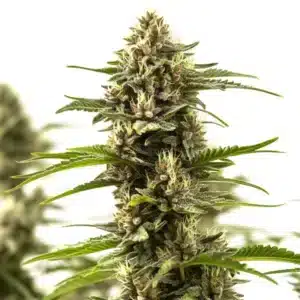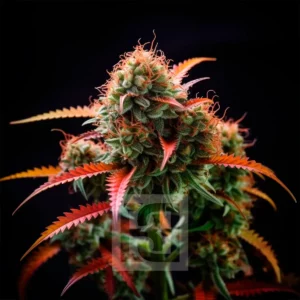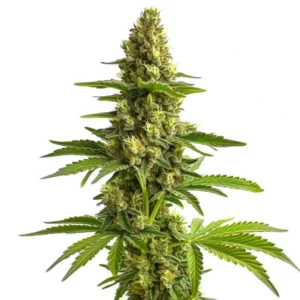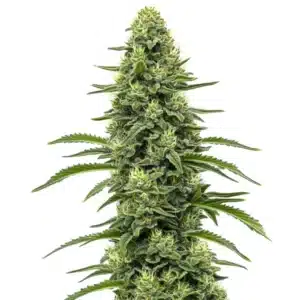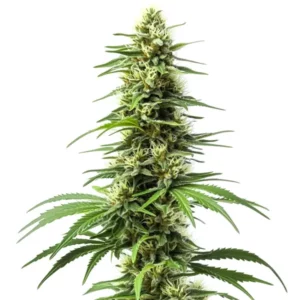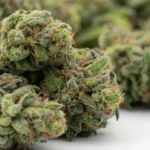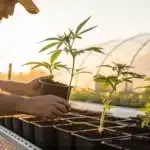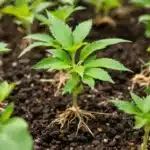
Transpiration and Hydroponic Cannabis: What You Need to Know
Transpiration and hydroponic cannabis: what you need to know is essential for any grower aiming to optimize plant health and yields. Grasping the concept of transpiration in your hydroponic cannabis setup can be a game-changer. This natural process, where plants release water vapor through small openings in their leaves, plays a crucial role. It affects everything from nutrient uptake to the overall health of your cannabis plants.
For both new and seasoned growers, knowing how transpiration rates in hydroponic cannabis growth differ from soil-based methods is key. Hydroponic systems often offer more control, but they also require careful monitoring of factors like humidity and temperature.
Recommended Strains
Blue Dream
|
|
THC | 17% - 24% (Medium) |
|
|
Type | Feminized |
|
|
Yield | High |
|
|
Phenotype | 50% Indica / 50% Sativa |
Girl Scout Cookies
|
|
THC | 18% - 25% (Medium) |
|
|
Type | Feminized |
|
|
Yield | High |
|
|
Phenotype | 60% Indica / 40% Sativa |
Humidity levels can have a significant impact on transpiration. Higher humidity can slow down the process, while lower humidity can speed it up. Finding the right balance is essential for optimizing nutrient uptake in hydroponic cannabis systems.
Managing Water Loss in Hydroponic Cannabis Cultivation
Water loss through transpiration can be a double-edged sword. On one hand, it’s necessary for nutrient transport within the plant. On the other, excessive water loss can lead to stress. In hydroponic systems, managing this balance is vital for plant health.
Consider using tools like hygrometers to monitor humidity levels. This can help you adjust your system to maintain optimal transpiration rates. A well-calibrated system can significantly enhance the efficiency of your hydroponic cannabis cultivation.
Effective management of water loss not only supports plant health but also prevents potential nutrient imbalances. By knowing the function of transpiration in hydroponic cannabis plant health, growers can create a stable environment. This ensures that nutrients are adequately transported to all parts of the plant, promoting vigorous growth.
Furthermore, regular monitoring and adjustments can help preemptively address issues related to water stress or nutrient deficiency. By taking a proactive approach, you can maintain a thriving hydroponic system that maximizes both yield and quality.
Practical Tips for Managing Transpiration
- Use fans to promote air circulation, which can help balance humidity levels.
- Regularly check and adjust nutrient levels to match plant needs.
- Monitor plant leaves for signs of stress, such as wilting or discoloration.
Implementing these tips can help you manage water loss effectively. Keeping a close eye on your plants and making adjustments as needed can prevent potential issues before they arise.
Additionally, consider using shade cloths or light diffusers to reduce excessive light exposure, which can exacerbate water loss. A balanced approach to light management can support healthy transpiration rates in hydroponic cannabis growth.
It’s also beneficial to schedule regular maintenance checks of your hydroponic system. Ensuring that pumps and timers are functioning correctly can help maintain a consistent environment, further supporting optimal transpiration and plant health.
Promos & Deals
Effects of Humidity on Hydroponic Cannabis Transpiration
Humidity directly influences how much water your plants release. High humidity levels can cause transpiration to slow down, potentially leading to nutrient deficiencies. On the other hand, low humidity can increase transpiration rates, risking water stress.
For hydroponic cannabis growers, knowing these effects is crucial. By controlling humidity, you can encourage healthy transpiration and nutrient uptake. This is particularly important for strains like Bruce Banner 3, known for its robust growth and high yield potential.
The effects of humidity on hydroponic cannabis transpiration highlight the importance of maintaining a balanced environment. High humidity can also increase the risk of mold and mildew, which can be detrimental to plant health. Therefore, consistent monitoring and adjustments are necessary to keep humidity within optimal ranges.
Using environmental control systems can automate the process of maintaining ideal humidity levels. These systems can be programmed to adjust settings based on real-time data, offering a hassle-free way to ensure the best conditions for your plants.

Balancing Humidity in Your Grow Room
Maintaining the right humidity level can be challenging. However, with the right tools and techniques, it’s entirely manageable. Dehumidifiers and humidifiers are your best friends in this endeavor.
- Install a hygrometer to constantly monitor humidity levels.
- Use a dehumidifier to reduce humidity when it gets too high.
- Consider a humidifier during drier months to keep levels in check.
These tools can help you create a stable environment, allowing strains like Blue Dream to thrive. This strain, available at Blimburn Seeds, is known for its adaptability and resilience, making it a great choice for varying conditions.
Setting up automated systems can further simplify the process of balancing humidity. These systems can help maintain consistency, reducing the risk of human error and allowing for more precise control over your grow room conditions.
Incorporating regular environmental assessments will provide valuable insights into your grow room’s conditions. By keeping detailed records, you can identify patterns and make informed adjustments to optimize your hydroponic cannabis setup.
Optimizing Nutrient Uptake in Hydroponic Cannabis Systems
In hydroponics, nutrients are delivered directly to the plant roots in a water solution. This can lead to faster growth compared to soil. However, it requires precise control of nutrient concentrations and pH levels.
Transpiration plays a crucial role in this process. As water evaporates from the leaves, it creates a pressure difference that draws nutrient-rich water up from the roots. This makes managing water loss in hydroponic cannabis cultivation essential for maximizing growth.
To optimize nutrient uptake, it is important to maintain a consistent feeding schedule tailored to the specific needs of your cannabis strains. Knowing the unique demands of each strain can help you adjust nutrient solutions accordingly.
Additionally, incorporating beneficial microorganisms can enhance nutrient absorption and plant resilience. These microorganisms work symbiotically with the plant roots, further supporting the role of transpiration in hydroponic cannabis plant health.
Ensuring Efficient Nutrient Uptake
To optimize nutrient uptake, start by selecting high-quality seeds. Strains like Girl Scout Cookies, available from Blimburn Seeds, are known for their high nutrient demands and excellent yield.
- Regularly test and adjust the pH of your nutrient solution.
- Ensure your plants have adequate light exposure to support photosynthesis.
- Monitor EC levels to maintain the right nutrient balance.
These practices not only support healthy growth but also enhance the quality and potency of your cannabis plants. By focusing on nutrient uptake, you can ensure your plants reach their full potential.
Utilizing advanced monitoring tools can provide real-time feedback on nutrient absorption rates, allowing for finer adjustments to your hydroponic system. This proactive approach can prevent nutrient imbalances and promote optimal plant health.
Regularly rotating crops and cleaning your hydroponic system can prevent the buildup of pathogens and ensure a fresh start for each new growth cycle. This not only aids in optimizing nutrient uptake but also promotes overall system health.

FAQs
What is transpiration, and why is it important for hydroponic cannabis?
Transpiration is the process of water vapor being released from plant leaves. It’s crucial because it helps transport nutrients from the roots to the rest of the plant. In hydroponic cannabis, efficient transpiration ensures that plants receive the nutrients they need to grow strong and healthy.
Managing this process can be a balancing act. Too much transpiration can lead to water stress, while too little can cause nutrient deficiencies. Knowing how factors like humidity affect transpiration rates in hydroponic cannabis growth is key to successful cultivation.
Transpiration and hydroponic cannabis: what you need to know is that mastering this balance can significantly impact your cultivation success. By fine-tuning environmental conditions, you can maintain the optimal transpiration rate that supports nutrient uptake and plant vigor.
Furthermore, adopting a holistic approach that includes environmental monitoring, nutrient management, and regular plant inspections can enhance the function of transpiration in hydroponic cannabis plant health, leading to a more robust and productive grow.
How does humidity affect hydroponic cannabis transpiration?
Humidity levels can significantly impact how much water plants transpire. High humidity can slow down transpiration, while low humidity can increase it. Both extremes can cause problems for your plants.
In a hydroponic setup, maintaining the right humidity is vital for plant health. It ensures that transpiration occurs at an optimal rate, supporting nutrient uptake and overall growth. Tools like hygrometers can help you monitor and adjust humidity levels as needed.
Knowing the effects of humidity on hydroponic cannabis transpiration is essential for creating an environment where plants can thrive. By adjusting humidity levels to match the needs of your specific strains, you can optimize growth and prevent stress-related issues.
For new growers, investing in a reliable humidity control system can simplify the process of maintaining the ideal conditions. This investment can pay off in the form of healthier plants and higher yields.
What are some signs of poor transpiration in cannabis plants?
Signs of poor transpiration in cannabis plants can include wilting, yellowing leaves, and stunted growth. These symptoms indicate that the plant is either losing too much water or not receiving enough nutrients.
Regularly monitoring your plants and adjusting environmental conditions can prevent these issues. By keeping an eye on factors like humidity and nutrient levels, you can ensure healthy transpiration and robust plant growth.
Additional indicators of poor transpiration might include leaf curling or browning at the edges. These symptoms can be early warnings that your plants are experiencing stress, and immediate action is required to rectify the situation.
By conducting regular health checks and maintaining detailed records of plant conditions, you can spot trends and make proactive adjustments to your hydroponic system, ensuring optimal transpiration rates and plant health.
Why is nutrient uptake important in hydroponic cannabis systems?
Nutrient uptake is vital because it directly impacts plant health and yield. In hydroponic systems, nutrients are delivered in a water solution, allowing for rapid absorption by the plant roots.
Efficient nutrient uptake supports faster growth and higher yields. By optimizing factors like pH and EC levels, you can enhance this process, ensuring your plants have everything they need to thrive.
Optimizing nutrient uptake in hydroponic cannabis systems not only maximizes growth potential but also improves the quality of the final product. Ensuring that plants receive a balanced diet of nutrients is crucial for achieving the desired potency and flavor profiles.
Additionally, implementing a comprehensive nutrient management plan that includes regular testing and adjustments can prevent common issues such as nutrient lockout or toxicity, safeguarding plant health and productivity.
How can I optimize my hydroponic system for better transpiration?
Optimizing your hydroponic system for better transpiration involves several steps. First, control the environment by managing humidity and temperature. This ensures that transpiration occurs at a healthy rate.
Additionally, focus on nutrient management. Regularly test and adjust your nutrient solution to maintain the right balance. These practices will help your cannabis plants grow healthier and produce better yields.
Incorporating technology such as automated environmental controls or nutrient dosing systems can streamline the process of optimizing your hydroponic system. These technologies provide real-time data and adjustments, ensuring conditions are consistently ideal for plant growth.
By remaining vigilant and adaptable, you can respond to changes in plant needs or environmental conditions swiftly. This proactive approach is key to maintaining a successful hydroponic cannabis operation.




